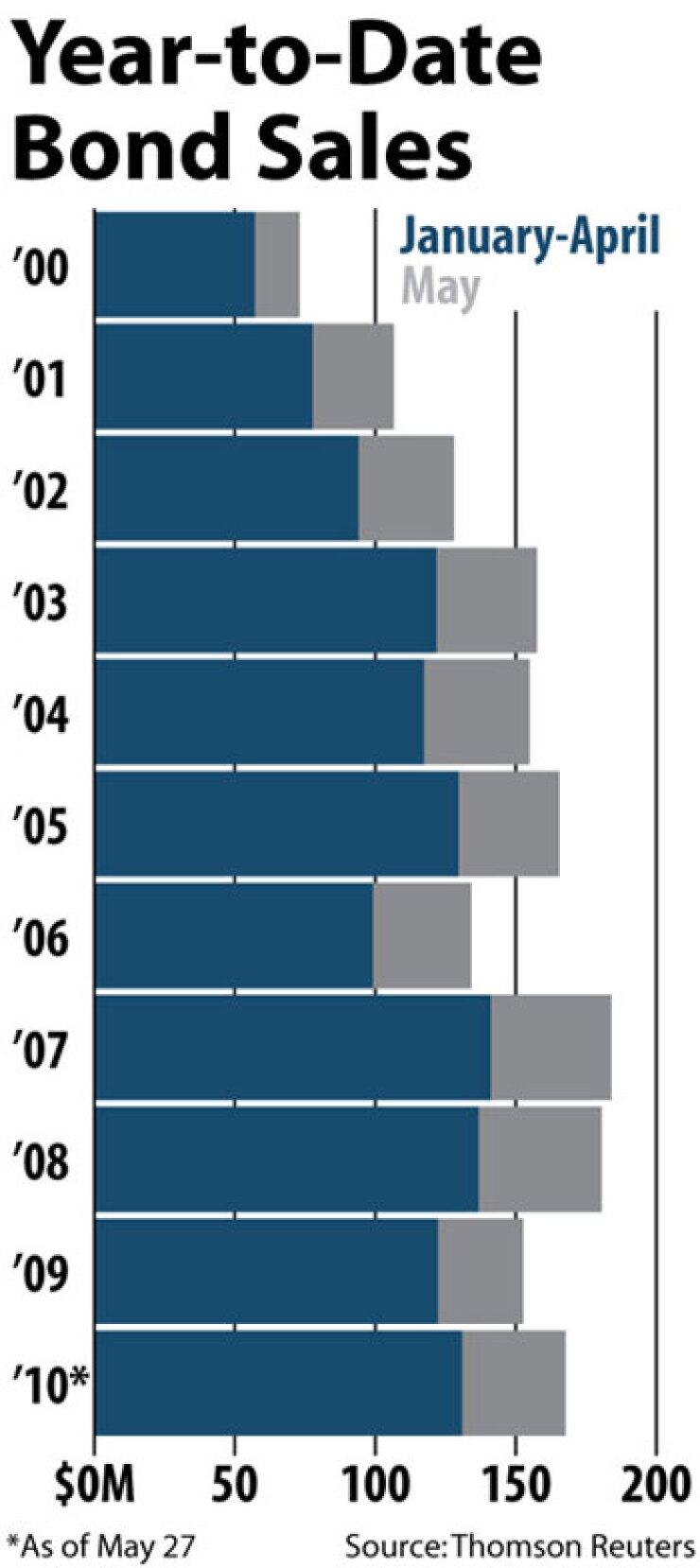
The migration of states and local governments into the taxable bond market continues to squeeze the supply of long-term, tax-free bonds.
Municipalities floated $36.86 billion of debt in May, according to preliminary data from Thomson Reuters.
This represented a 21.2% increase from May 2009, and the fourth-heaviest slate of issuance for May since Thomson started keeping track in the early 1980s.
But the story of the month’s issuance is more complicated than that.
Municipalities sold $12.08 billion of taxable debt in May, mostly Build America Bonds — the taxable municipal security established by the American Recovery and Reinvestment Act of 2009.
Issuance of tax-exempt bonds, the traditional fixture of municipal finance, shrank 7.2% for the month to $24.55 billion.
By allowing states and local governments to sell taxable debt, the BAB program enabled them to access new types of investors such as pension funds, which do not pay federal taxes and therefore have no reason to bid for tax-exempt paper.
Issuers have sold about $107 billion of BABs since the program’s inception. At least some portion of that would have otherwise been issued as tax-exempt debt.
Generally, issuers that have sold BABs have found they could save money by issuing long-term BABs. The average maturity of a BAB is about 28 years, according to a Wells Fargo index tracking the sector.
That means issuers’ growing usage of BABs has drained supply from long-term tax-exempt bonds.
Tax-exempt supply for the first five months of 2010 is down 16.8%.
“BABs continue to siphon off tax-exempt volume,” said Chris Mauro, director of municipal bond research at RBC Capital Markets. “The relative scarcity of tax-exempts on the long end continues unabated.”
About 25% of the money municipalities borrowed in May came through BABs. Nearly a third of the bonds municipalities have sold this year have been taxable debt; about 25% of the total is BABs.
The effect is even more dramatic when one considers that 18% of the bonds sold in May were issued to refinance existing debt.
Because BABs cannot be used to refinance debt, virtually all the refunding bonds municipalities sold in May were likely tax-exempt.
Mauro estimates that 40% of the bonds municipalities are selling to raise new money are BABs.
Until 2008, at least 80% of municipal bond issuance annually was tax-exempt, often significantly more. So far this year, only two-thirds of issuance is tax-exempt.
Nor is the scarcity of tax-exempt paper likely to ebb this year.
Under the BABs program as it is currently written, municipalities collect a federal subsidy equal to 35% of their interest costs.
That legislation is slated to sunset at the end of 2010. While prospects for renewal appear strong, most of the proposals for extension entail a reduction in the subsidy — in one bill, for example, to 30%.
That will probably prompt issuers to scramble to sell BABs this year while they still carry a 35% subsidy, said Chris Mier, managing director at Loop Capital Markets.
The scarcity of long-term tax-exempt paper has helped keep yields on long-term municipal bonds low.
The 30-year triple-A municipal bond yields about 4%, according to Municipal Market Data, which is only 20 basis points higher than its all-time low.
It has held the ratio of long-term municipal yields against Treasury yields fairly steady, despite a mighty rally in Treasuries last month and a barrage of panicked doomsday prophesy about the fate of municipal credit in the press.
Mier said the low interest rates have encouraged municipalities to tap the bond market to attain attractive borrowing costs.
Every year, Loop Capital predicts annual muni bond volume based on a regression analysis weighing such factors as the level of interest rates and the ratio of interest rates to Treasury rates.
The current low level of municipal borrowing costs have stimulated issuance, Mier said.
At the beginning of the year, Loop forecast $435 billion of municipal bond volume for 2010, which would be the largest amount of munis ever sold in a single year. Mier remains comfortable with the prediction.
The proportion of municipal volume last month that was taxable was a bit below the trend for 2010.
This may have been in part attributable to the biggest municipal deal for the month, which for a change was tax-exempt.
The California Department of Water Resources floated a $2.99 billion batch of revenue bonds — the third-biggest for any issuer this year, and the biggest tax-exempt deal.
The money will be used to refinance part of the massive $11.3 billion deal the DWR issued in 2002 to cope with rising power costs following the state’s energy crisis.
The biggest deal in each of the first four months of the year had at least some taxable component, including the $3.47 billion bond Illinois sold to raise money to help fund the state’s pension liabilities. That remains the biggest municipal deal in 2010.
The biggest BAB deal in May was the $1.16 billion Washington general obligation offering. The state plans to use the money to build highways, and for other transportation projects.
Municipalities continued to shift away from variable-rate debt, presumably because of the prohibitive cost of the bank letters of credit needed to secure these instruments.
Issuers sold just $1.87 billion of variable-rate debt with a short put option in May.
Bond insurance also continued to lose relevance, with just $2.1 billion of insured municipal bonds coming to market for the month, or 5.7% of the total.





